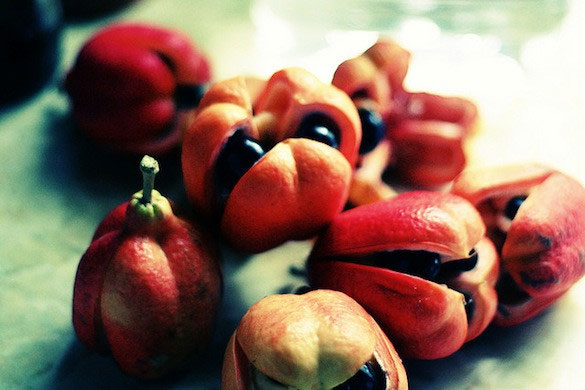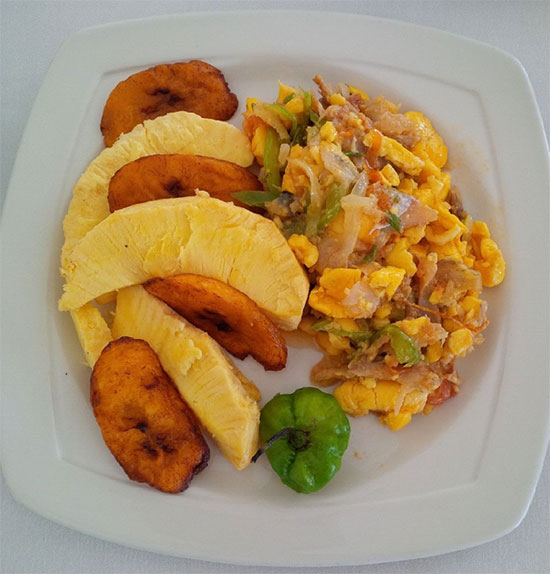The unusual Ackee fruit from Jamaica, originating from West Africa, is vibrant and delicious-looking. However, its appearance can be deceiving; if you don’t know how to eat it, you could die within 24 hours.
The fastest man in the world, athlete Usain Bolt, is known to enjoy dishes made from Ackee every morning, which only adds to the curiosity surrounding this fruit.
Ripe Ackee turns a reddish-yellow and opens up on its own, but if you’re not wise enough to open a ripe one and taste the inside, you could quickly become a victim of Jamaican vomiting sickness, technically known as hypoglycin poisoning. You could die within a day.

Ackee is a peculiar fruit.
Despite all this, Jamaicans love the golden flesh of the Ackee fruit, and it is a key ingredient in their national dish.
Ackee is a pear-shaped fruit found in warm climates. When ripe, it changes from green to bright red to orange-yellow, splitting open to reveal three large, shiny black seeds, each surrounded by soft, white to yellow flesh.
The toxin hypoglycin B in Ackee is only found in the seeds and is not released, which is not a concern. The delicious and appealing part of this fruit is the thick, spongy, bright yellow flesh surrounding the seeds, which has a creamy flavor.
This fruit was imported to Jamaica from East Africa before 1725. Today, Ackee is canned and is one of Jamaica’s main export items.
Due to its suitability for Jamaica’s tropical climate, this fruit thrives here. Nowadays, visitors to this country will see a large number of Ackee trees growing everywhere, from Montego Bay to the gardens of Goldeneye…
Ackee and Saltfish

Jamaica’s national dish made from Ackee.
When preparing dishes from Ackee, Jamaicans typically eat it with saltfish (usually made from cod). Chef Cuthbert Binns, a long-time head chef at a restaurant in Jamaica, shares how to prepare it in a nutritious way without the risk of poisoning.
This involves boiling the Ackee with saltfish for 20 minutes, then draining and removing the fish bones. Next, the chef will sauté tomatoes, onions, and garlic in a pan, then add the mixture and sprinkle thyme and black pepper before serving.
The sautéed Ackee and saltfish dish boasts a rich flavor from the fish and the creamy aroma of Ackee, making it irresistible. The flesh of the Ackee becomes yellower and softer when cooked, melting in your mouth like scrambled eggs. Jamaicans often enjoy this sautéed dish with bread and fried bananas. At least once a day, they must have a meal featuring sautéed Ackee and saltfish.
When cooked, the flesh of the Ackee turns a buttery yellow, with a creamy flavor that balances perfectly with the salty richness of the saltfish. This dish is also a popular breakfast choice among locals.
Nowadays, with a more affluent economy, Jamaicans have adapted many savory dishes with Ackee, such as stir-frying it with pork. However, they still prefer the combination of Ackee and saltfish the most.
For Jamaicans, sautéed Ackee and saltfish evoke memories of a painful past, struggles, and a spirit of unity and sharing to overcome difficulties together. Residents here always remind their children that no matter where they go or how many delicious dishes they try, they should never forget sautéed Ackee and saltfish from their homeland.
Not only is Ackee popular among Jamaicans, but in West Africa, the seeds and skin of this fruit are also used to make cleaning soap. Meanwhile, in Haiti, there have been incidents of people dying from eating unripe Ackee.
- 15 fruits in Vietnam that made it to the list of the 25 strangest fruits in the world
- Vietnam proudly owns 3 of the 10 rarest fruits in the world
- What happens when you put sugar in a car’s gas tank?
- The funniest facts in world history
- Once you know how gummy bears are made, you won’t want to eat them anymore

















































